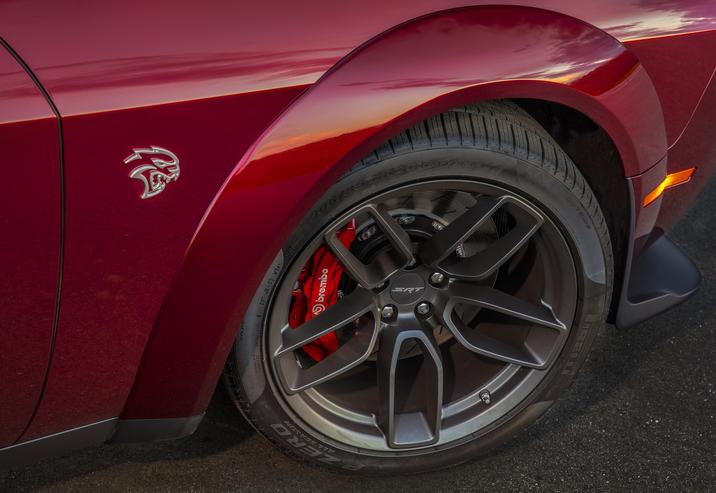Dodge's Challenger SRT Hellcat Widebody Adds Some Much-needed Grip

The Dodge Challenger SRT Hellcat gets a new variant for the 2018 model year, and it just happens to be the widebody model track day enthusiasts have been clamoring for since the car’s initial announcement.
Borrowing the fender flares and front lip from the Dodge Demon, the Hellcat keeps its 707-horsepower supercharged V8 while adding extra room for more rubber. Since the supercharged Challenger is notoriously poor at transferring its power to the pavement, the wider 305/35ZR20 Pirelli P-Zero performance tires allow for superior cornering and straight-line speed.
Dodge claims the widebody shaves 0.3 seconds off the “normal” Hellcat’s 1/4 mile time for a lean ETA of 10.9 seconds. It also says the 305mm rubber helps the beast claw its way from 0.93 lateral g to 0.97 — while not earth-shattering, it’s still a major improvement. FCA has also changed the steering to an electric unit with selectable presets, claiming improved road feel, precision, and usability at lower speeds.
However, it’s the looks that benefit the most from the extra 3.5 inches of width the widebody brings to the table. Even if you never plan on bringing the car to a track, you can still look at it in the garage and feel like you made the correct purchase as you caress the fender flares. The only measurable downside is that the added drag limits the fatter cat to 195 mph.
Dodge’s 2018 Challenger SRT Hellcat Widebody opens to dealer orders in July and will begin arriving in the third quarter of this year. Tires, wheels, and width does come at a premium, however. Pricing begins at $72,590 — seven grand over the standard Hellcat’s MSRP but still significantly less than Dodge Demon’s.
[Images: Fiat Chrysler Automobiles]

A staunch consumer advocate tracking industry trends and regulation. Before joining TTAC, Matt spent a decade working for marketing and research firms based in NYC. Clients included several of the world’s largest automakers, global tire brands, and aftermarket part suppliers. Dissatisfied with the corporate world and resentful of having to wear suits everyday, he pivoted to writing about cars. Since then, that man has become an ardent supporter of the right-to-repair movement, been interviewed on the auto industry by national radio broadcasts, driven more rental cars than anyone ever should, participated in amateur rallying events, and received the requisite minimum training as sanctioned by the SCCA. Handy with a wrench, Matt grew up surrounded by Detroit auto workers and managed to get a pizza delivery job before he was legally eligible. He later found himself driving box trucks through Manhattan, guaranteeing future sympathy for actual truckers. He continues to conduct research pertaining to the automotive sector as an independent contractor and has since moved back to his native Michigan, closer to where the cars are born. A contrarian, Matt claims to prefer understeer — stating that front and all-wheel drive vehicles cater best to his driving style.
More by Matt Posky
Latest Car Reviews
Read moreLatest Product Reviews
Read moreRecent Comments
- Analoggrotto I don't see a red car here, how blazing stupid are you people?
- Redapple2 Love the wheels
- Redapple2 Good luck to them. They used to make great cars. 510. 240Z, Sentra SE-R. Maxima. Frontier.
- Joe65688619 Under Ghosn they went through the same short-term bottom-line thinking that GM did in the 80s/90s, and they have not recovered say, to their heyday in the 50s and 60s in terms of market share and innovation. Poor design decisions (a CVT in their front-wheel drive "4-Door Sports Car", model overlap in a poorly performing segment (they never needed the Altima AND the Maxima...what they needed was one vehicle with different drivetrain, including hybrid, to compete with the Accord/Camry, and decontenting their vehicles: My 2012 QX56 (I know, not a Nissan, but the same holds for the Armada) had power rear windows in the cargo area that could vent, a glass hatch on the back door that could be opened separate from the whole liftgate (in such a tall vehicle, kinda essential if you have it in a garage and want to load the trunk without having to open the garage door to make room for the lift gate), a nice driver's side folding armrest, and a few other quality-of-life details absent from my 2018 QX80. In a competitive market this attention to detai is can be the differentiator that sell cars. Now they are caught in the middle of the market, competing more with Hyundai and Kia and selling discounted vehicles near the same price points, but losing money on them. They invested also invested a lot in niche platforms. The Leaf was one of the first full EVs, but never really evolved. They misjudged the market - luxury EVs are selling, small budget models not so much. Variable compression engines offering little in terms of real-world power or tech, let a lot of complexity that is leading to higher failure rates. Aside from the Z and GT-R (low volume models), not much forced induction (whether your a fan or not, look at what Honda did with the CR-V and Acura RDX - same chassis, slap a turbo on it, make it nicer inside, and now you can sell it as a semi-premium brand with higher markup). That said, I do believe they retain the technical and engineering capability to do far better. About time management realized they need to make smarter investments and understand their markets better.
- Kwik_Shift_Pro4X Off-road fluff on vehicles that should not be off road needs to die.







































Comments
Join the conversation
Still slower than a Miata. https://www.youtube.com/watch?v=NSq5Zb5ZNWY
It needs its name changed to Fat Cat and to come eblazoned with a hot rod cat cartoon vinyl (Ed Roth style optional).